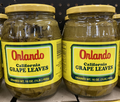food.wikisort.org - Dish
Grape leaves, the leaves of the grapevine plant, are used in the cuisines of a number of cultures. They may be obtained fresh, or preserved in jars or cans.[1][2] The leaves are commonly rolled or stuffed with mixtures of meat and rice to produce dolma, found widely in the Mediterranean, Balkans, and Middle East.[3] They may also be used in various other recipes and dishes.[4] When cut into smaller pieces they are used as a savory addition to soups that include greens and cabbage.[5]
 Merchant selling grape leaves in Damascus (2008) | |
Nutrition
Canned grape leaves (cooked, salted) are 76% water, 12% carbohydrates, 4% protein, and 2% fat.[6] In a reference amount of 100 grams (3.5 oz), the leaves supply 69 calories and are a rich source (20% or more of the Daily Value, DV) of sodium (119% DV), vitamin A (105% DV), copper (95% DV), pantothenic acid (43% DV), and several other B vitamins and dietary minerals.[6]
Gallery
 Preserved grape leaves in jars
Preserved grape leaves in jars- Stuffed grape leaves with yogurt mint sauce
See also
- Grape seed
- List of grape dishes
References
- Ingalls, Julia. "The Complicated Comfort Of Syrian Grape Leaves". LAist. Retrieved 2020-12-16.
- Sakellis, Eleni. [https:/www.thenationalherald.com/food_travel_food/arthro/dolamadakia_stuffed_grape_leaves-584815/ "Dolamadakia, Stuffed Grape Leaves"]. The National Herald. Retrieved 2020-12-16.
{{cite web}}: Check|url=value (help) - Davidson, Alan, ed. (2014). The Oxford Companion to Food. Oxford University Press. p. 879. ISBN 978-0-19-967733-7 – via Google Books.
- "Grape Leaf Herb and Yogurt Pie". The Splendid Table. Retrieved 2020-12-16.
- John Thorne. Simple Cooking. Farrar, Straus and Giroux; 16 November 1996. ISBN 978-0-86547-504-5. p. 183–.
- "Grape leaves, cooked, canned and salted (varies by manufacturer)". Nutritiondata.com, Conde Nast and US Department of Agriculture. 2018. Retrieved 17 December 2021.
Другой контент может иметь иную лицензию. Перед использованием материалов сайта WikiSort.org внимательно изучите правила лицензирования конкретных элементов наполнения сайта.
WikiSort.org - проект по пересортировке и дополнению контента Википедии


